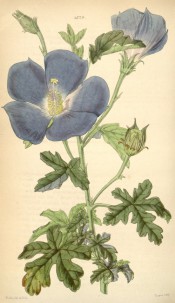Hibiscus huegelii Endl. var. grossulariifolius (Miq.) Benth.
The type Hibiscus huegelii is a rounded shrub with deeply lobed leaves and lilac flowers, to 12cm across, in spring and summer. To 2m. [Wrigley].
Horticultural & Botanical History
Curtis’s Botanical Magazine figures this plant as Hibiscus grossulariaefolius. ‘I cannot assert with certainty that this is the H. grossulariaefolius of Miquel, for it does not in all respects accord with the description: neither in our recent or dried specimens can it be said of our plant, “totus lutescenti-stellato-tomentosus”; nor can the leaf-stalks or peduncles be considered “short”, nor the involucre 8- (but 10-12-) fid; and the stigma is not capitate, but dilated and lobed. Still the general characteristics are so similar that the differences may be accounted for on the supposition that the able Miquel described from an imperfect dried specimen of Preiss. I run the risk of retaining the name, rather than load the system with needless synonyms. Australia does not seem eminently rich in species of Hibiscus; but some of them are eminently beautiful; and the present one is no exception. It was raised in the Royal Gardens of Kew from Swan-River seeds, sent by Mr. Drummond, and has this character to recommend it, that in the summer, if planted against a wall, it makes a beautiful open border plant, flowering frequently during the summer months.’ [BM t.4329/1847].
‘It is impossible to compare this very handsome Hibiscus [Hibiscus huegelii var. quinquevulnera] with our figure of H. grossulariaefolius (Bot. Mag. t. 4329) without considering it, save in the colour of the flowers, specifically the same, but varying in the colour of the flower. So again the H. Wraye of Dr. Lindley (Bot. Reg. 1840, t. 69) is quite identical, even in the colour of its flowers, with H. grossulariaefolius. Both these and several other supposed species, as may be seen by the above list of synonyms, Mr. Bentham has, I do not doubt correctly, referred to Endlicher’s H. Huegelii. But among the five varieties he has enumerated the present does not seem to be included, perhaps because, depending on colour, the dried specimens do not exhibit the peculiar differences: in the figures above quoted the petals are of an almost uniform dull purplish-blue colour, here deep rose, paler below, and each petal with a black-blood-coloured spot on the claw. All the varieties inhabit the Swan River settlement and the south-west coast of Australia. We owe the possession of our plant (which flowered in August, 1853) to Mr. Thomson, of Ipswich.’ [BM t.5406/1863].
History at Camden Park
Hand-written in an 1850 catalogue in the Mitchell Library collection, inscribed on the front Wm. Macarthur, 23rd. Dec. 1854. [ML 635.9m]. Certainly grown in the gardens at this time.
Notes
Published Jan 11, 2010 - 01:41 PM | Last updated Jul 27, 2010 - 04:46 PM
| Family | Malvaceae |
|---|---|
| Category | |
| Region of origin | South and Western Australia |
| Synonyms |
|
| Common Name | |
| Name in the Camden Park Record |
Hibiscus grossulariifolius |
| Confidence level | high |
